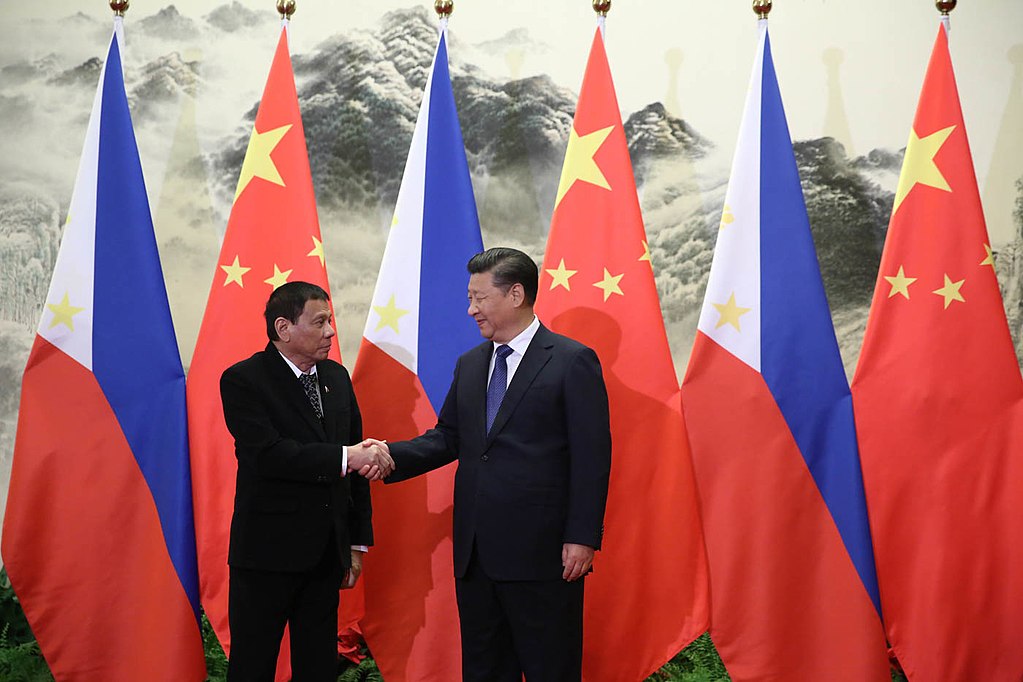
In a telltale sign of improving bilateral relations, the Philippines and China have announced a preliminary agreement to pursue a joint development agreement (JDA) in the South China Sea. Yet, the proposal remains deeply controversial in the Philippines, where members of the security establishment, civil society, and broader intelligentsia view any resource-sharing agreement with China as illegal, both based on the Philippine constitution as well as the 2016 arbitration award ruling at The Hague.
Thus, the challenge is for both sides to find a goldilocks legal compromise, which appeases domestic constituencies without undermining their respective sovereignty claims. In the meantime, however, China is simply purchasing additional diplomatic time, while changing facts on the ground on a daily basis.
Finding a Compromise
During a late-March meeting with his Chinese counterpart Wang Yi in Beijing, Philippine Foreign Secretary Alan Peter Cayetano hailed a “golden period” in bilateral ties, claiming the “South China Sea disputes will no longer block the development of bilateral ties,” but instead, “will be turned into a source of friendship and cooperation between our two countries.” During the meeting, both sides agreed to pursue “offshore oil and gas exploration” based on a “suitable legal framework.” In turn, Mr. Wang said the two sides are exploring “in a prudent and steady way advanced cooperation on offshore oil and gas exploration.”
Last year, Philippine President Rodrigo Duterte went as far as suggesting “co-ownership” of precious minerals, energy and fisheries resources in the disputed waters. The Filipino president has prioritized the normalization of bilateral ties with China even at the expense of his country’s traditional alliance with America. Nonetheless, so far, it’s far from clear whether the Philippines and China are pursuing JDAs, per the provisions (Part IX) of the United Nations Convention on the Law of the Sea (UNCLOS), or, alternatively, are considering more flexible confidence-building measures (CBMs.)
The stakes are high. If the two sides were to pull off a successful outcome, this could set a strong precedent for China’s maritime and territorial disputes with other claimant states, namely Vietnam, Malaysia and Brunei. The problem, however, is that there is no encouraging precedent so far. In 2005, the Philippines, China, and Vietnam signed the Joint Maritime Seismic Undertaking (JMSU). Under the agreement, the details of which have yet to be fully revealed to the public, China’s energy giant China National Offshore Oil Corporation (CNOOC) was tasked with undertaking seismic exploration in areas of overlapping claims in the South China Sea. In turn, the Philippine National Oil Company (PNOC) was tasked with interpretation of the data, while Petrovietnam was charged with processing it.
Three years earlier, China and Vietnam negotiated a bilateral maritime delimitation agreement, as a basis for a JDA arrangement, in the Gulf of Tonkin. Both sides hoped to leverage any successful experience in this geographical area by exploring JDAs in their areas of overlapping claims in the South China Sea, where both Hanoi and Beijing have led a decades-long battle for domination of the Paracels, which are currently in full control of China, and the Spratlys, where Vietnam controls the largest number of land features.
Yet, both the Gulf of Tonkin arrangement as well as the JMSU agreements either failed to come to fruition, were abandoned by the involved parties, or were mired in controversy. Vietnam has consistently complained about China’s failure to comply with the provisions of the 2002 agreement in the Gulf of Tonkin, while civil society groups in the Philippines challenged the JMSU as unconstitutional.
Nonetheless, there are, at the very least, three possible arrangements that can be pursued by the Philippines and China. Some are more likely to cause a political backlash, and risk violating domestic jurisprudence as well as international law, while others have the potential of providing a basic framework for managing, if not resolving, the South China Sea disputes.
Menu of Compromise
The first and most feasible option is the Philippines subcontracting a Chinese company, as a subcontractor and in cooperation with a local company, to explore and develop energy resources beyond the Southeast Asian country’s Exclusive Economic Zone (EEZ) as well as China’s nine-dashed-line claims. The Philippines, for instance, has had this arrangement with Chevron and Shell in the Camago-Malampaya project (Service Contract 38). There is currently a proposal for the Philippine National Oil Company to partner with China’s energy giant CNOOC, with Jadestone Energy Inc. as a minority stake. The joint venture is expected to be in the Calamian project off the island of Palawan, which doesn’t fall within China’s nine-dashed-line claim. Crucially, CNOOC is expected to hold a 51 percent majority stake. Per the Philippine government’s interpretation of the Philippine constitution, restrictions on a foreign equity share only apply to the final profit, not ownership of the subcontracted project per se (thus the majority stake of Shell-Chevron in the Camago-Malampaya project.)
The other proposed arrangement could be a confidence-building measure (CBM) in the form of the creation of a marine and ecological sanctuary in contested land features, particularly the Scarborough Shoal. This way, both parties can conserve and regulate the sustainable exploitation of fisheries resources in the area; suspend sovereignty disputes; and avoid ecological disaster in endangered zones.
The above two arrangements don’t fulfill the strict definition of JDAs as per international law, but will likely be acceptable to domestic constituencies in both countries, particularly in the Philippines. An actual JDA within the Philippines’ EEZ or China’s nine-dashed-line claim, however, runs the risk of violating both the Philippine constitution, which demands recognition of Philippine sovereignty by contracting parties, as well as the landmark arbitration award ruling of 2016, which ruled the absence of any overlapping claims between the two claimants.
Prominent voices within the Philippine political establishment, such as interim Supreme Court Chief Justice Antonio Carpio, have described any JDA with China as unconstitutional and in violation of The Hague tribunal ruling. There is fear that any JDA with China could end up legitimizing China’s sweeping claims across the South China Sea, much to the detriment of other Southeast Asian countries, namely Vietnam and Indonesia, which have rejected the nine-dashed-line claims. Carpio’s opinion is largely resonant among China-skeptic elements within the Philippine defense establishment as well as the broader civil society, which have constantly criticized Duterte’s perceived acquiescence to Beijing. Thus, an actual JDA seems too politically risky for the Duterte administration, potentially provoking a strong backlash against the ongoing rapprochement with China.
In geopolitical terms, however, China benefits from the mere discussion of a JDA. After all, so long as discussions – regardless of their substance – of resource-sharing arrangements are on the table, Beijing can effectively forestall any pushback by smaller claimant states such as the Philippines, while projecting a more peaceful image to its broader neighborhood.


